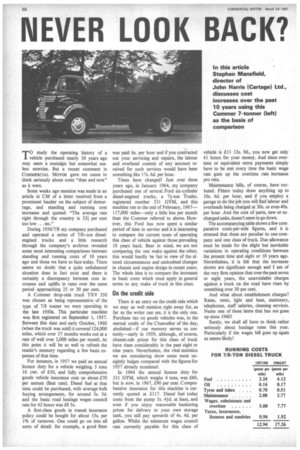NEVER LOOK BACK?
Page 60

If you've noticed an error in this article please click here to report it so we can fix it.
Fro study the operating history of a .1. vehicle purchased nearly 10 years ago may seem a nostalgic but somewhat useless exercise. But a recent comment in COMMERCIAL MOTOR gave me cause to think seriously about costs "then and now" as it were.
Some weeks ago mention was made in an article in CM of a letter received from a prominent haulier on the subject of demurrage, and standing and running cost increases and quoted: "The average rate right through the country is 331 per cent too low . .. etc."
During 1956/7/8 my company purchased and operated a series of 7/8-ton dieselengined trucks and a little research through the company's archives revealed some most interesting comparisons between standing and running costs of 10 years ago and those we have to face today. There seems no doubt that a quite unbalanced situation does in fact exist and there is certainly a discrepancy between cost increases and uplifts in rates over the same period approaching 25 or 30 per cent.
A Commer drop-side truck TXV 350 was chosen as being representative of the type of 7/8 tonner we were operating in the late 1950s. This particular machine was first registered on September 1, 1957. Between this date and early October, 1960 (when the truck was sold) it covered 124,000 miles, which over 37 months works out at a rate of well over 3,000 miles per month. At this point it will be as well to refresh the reader's memory regarding a few basic expenses of that time.
For instance, in 1957 we paid an annual licence duty for a vehicle weighing 3 tons 16 cwt. of £50, and fully comprehensive goods vehicle insurance cost us about £70 per annum (fleet rate). Diesel fuel at that time could be purchased, with average bulk buying arrangements, for around 3s. 5d. and the basic road haulage wages council rate for 42 hours was £8 5s.
A first-class goods in transit insurance policy could be bought for about 15s. per 196 of turnover. One could go on into all sorts of detail: for example, a good fitter was paid 6s. per hour and if you contracted out your servicing and repairs, the labour and overhead content of any account received for such services would have been something like 17s. 6d. per hour.
Times have changed! Just over three years ago, in January 1964, my company purchased one of several Ford six-cylinder diesel-engined trucks, a 7÷-ton Trader, registered number 331 GYM, and this machine ran to the end of February, 1967117,000 miles-only a little less per month than the Commer referred to above. However, this Ford has now spent a similar period of time in service and it is interesting to compare the current costs of operating this class of vehicle against those prevailing 10 years back. Bear in mind, we are not comparing the one make against the other; this would hardly be fair in view of the altered circumstances and undoubted changes in chassis and engine design in recent years. The whole idea is to compare the increases in basic costs which must apply in general terms to any make of truck in this class.
On the credit side There is an entry on the credit side which we may as well mention right away for, as far as the writer can see, it is the only one. Purchase tax on goods vehicles was, to the eternal credit of the Chancellor of the day, abolished-if our memory serves us correctly-early in 1959, although, of course, chassis-cab prices for this class of truck have risen considerably in the past eight or nine years. Nevertheless, the vital statistics we are considering show some most unsightly bulges compared with the figures for 1957 already examined.
In 1964 the annual licence duty for 331 GYM, which weighs 4 tons, was £60, but is now, in 1967, £90 per year_ Comprehensive insurance for this machine is currently quoted at £117. Diesel fuel today costs from the pump 5s. 41-d. at least, and even if you enjoy reasonable bunkering prices for delivery to your own storage tank, you still pay upwards of 4s. 4d. per gallon. Whilst the minimum wages council rate currently payable for this class of vehicle is El 1 12s. 9d., you now get only 41 hours for your money. And Since overtime or equivalent extra payments simply have to be met every time the basic wage rate goes up the overtime rate increases pro rata.
Maintenance bills, of course, have rocketed. Fitters today draw anything up to 10s. 6d. per hour, and if you employ a garage to do the job you will find labour and overheads being charged at 30s. or even 40s. per hour. And the cost of parts, new or exchanged units, doesn't seem to go down.
The accompanying table shows a few comparative costs-per-mile figures, and it is stressed that these are peculiar to one company and one class of truck. Due allowance must be made for the slight but inevitable variations in operating conditions between the present time and eight or 10 years ago. Nevertheless, it is felt that the increases shown are significant enough and I am of the very firm opinion that over the past seven or eight years, the unavoidable charges against a truck on the road have risen by something over 30 per cent.
And what about establishment charges? Rates, rents, light and heat, stationery, telephones, staff salaries, cleaning services. Name one of these items that has not gone up since 1960!
Surely, we shall all have to think rather seriously, about haulage rates this year. Particularly if the wages bill goes up again as seems likely!








































































































